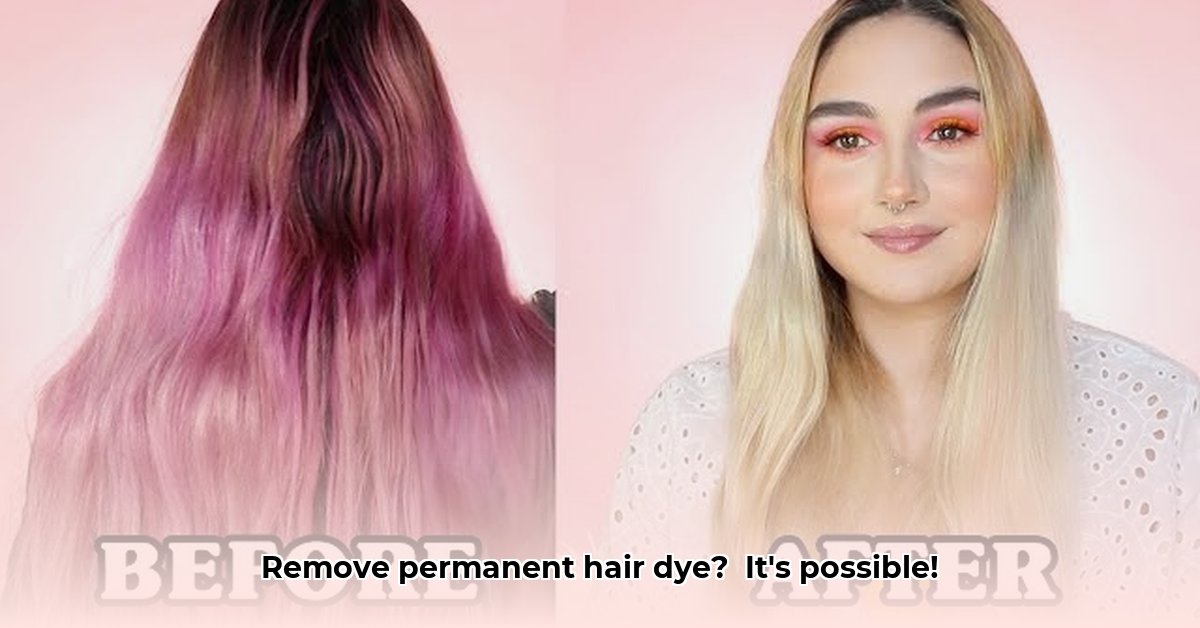Fading Unwanted Color: A Realistic Approach
So, your permanent hair dye adventure took an unexpected turn? You’re not alone. Many find themselves yearning for a color do-over after a DIY dye session. While professional color correction offers the safest and most effective route, especially for dramatic changes, several at-home methods can help lighten or fade permanent hair dye. Keep in mind, “permanent” dye is tenacious, and home remedies demand patience and realistic expectations. Think gradual fading, not instant color removal.
Understanding Hair Dye and Its Removal
“Permanent” hair dye contains molecules that penetrate the hair shaft, altering its color. These molecules are designed for longevity, making removal a challenge. Your hair’s porosity (its ability to absorb moisture) also plays a crucial role. Highly porous hair readily absorbs dye, but it’s also more susceptible to damage during removal. Before attempting DIY methods, consider your hair’s porosity and the dye’s darkness. This informs your approach and manages expectations, as supported by research in the Journal of Cosmetic Science. The deeper the dye penetrates, the harder it is to extract.
DIY Removal Methods: Pros, Cons, and Cautions
Several at-home remedies can help fade unwanted hair color. Let’s explore common methods, including their potential benefits and drawbacks. A patch test on a small, hidden section of hair is crucial before any full-scalp application. This helps prevent allergic reactions or undesirable results.
1. Clarifying Shampoo and Baking Soda
This gentle method utilizes clarifying shampoo to remove product buildup and baking soda as a mild abrasive to lift surface color. Mix a small amount of baking soda with your clarifying shampoo, apply to wet hair, massage gently, and rinse thoroughly. Repeat weekly, but avoid overuse, which can dry out your hair. This method is best for gradual fading, especially with lighter dyes, but it’s unlikely to completely remove dark, stubborn color. Consider it a color softener, not an eraser. For added moisture, incorporate a deep conditioner after each treatment. How often should you clarify? Once a week is usually sufficient.
2. Vitamin C Treatment
Vitamin C (ascorbic acid) can help break down dye molecules. Crush vitamin C tablets, mix the powder with conditioner, apply to damp hair, leave for 1-2 hours (or overnight), and rinse. Repeat every few days, monitoring your hair’s condition. While generally gentler than baking soda, vitamin C treatments can also be drying. Follow up with a deep conditioner to replenish moisture. Studies show Vitamin C can lighten hair, but the effect is gradual. What type of Vitamin C is best? Pure ascorbic acid powder is most effective.
3. Vinegar Rinse
Diluted white vinegar (1 part vinegar to 4 parts water) can slightly alter hair pH, potentially affecting the dye. Use as a final rinse after shampooing. While vinegar is a mild option with potential shine-enhancing benefits, it’s unlikely to dramatically fade dark dye. The smell can be a drawback. Proper dilution is crucial to prevent irritation. What type of vinegar should you use? White vinegar is recommended for its acidity.
4. Oil Treatments
Oils like olive or coconut oil can help loosen dye molecules due to their emollient properties. Apply generously to dry hair, leave overnight, and shampoo thoroughly in the morning. This method is gentle and moisturizing, but it’s more effective at removing semi-permanent dyes than “permanent” ones. It’s a color softener, particularly beneficial for dry or damaged hair. Which oil is most effective? Both olive and coconut oil can be beneficial. Experiment to see which works best for your hair type.
5. Dish Soap and Shampoo
Dish soap, with its strong detergents, can help strip hair color, but it also strips natural oils, leading to dryness. Mix a few drops of dish soap with your regular shampoo. Apply to wet hair, lather, and rinse thoroughly. Follow immediately with a deep conditioner. This method should be used sparingly due to its drying potential. How often can you use dish soap? Limit use to once or twice a week, depending on your hair’s resilience.
6. Professional Color Removers
For stubborn permanent dyes, professional color removers offer a more potent solution. These products are available at beauty supply stores and are designed to shrink the dye molecules, making them easier to rinse out. Always follow the product instructions carefully and perform a strand test before applying to your entire head. What are the risks of color removers? They can be drying and may cause irritation if misused.
Choosing the Right Method: A Risk Assessment
The efficacy and risk of each method vary based on hair type, dye used, and individual sensitivities. Consider the following factors when selecting a method:
- Hair Porosity: Highly porous hair is more susceptible to damage. Gentler methods are recommended.
- Dye Darkness: Darker dyes are more difficult to remove. Multiple treatments or stronger methods might be necessary.
- Hair Condition: Damaged or dry hair requires extra care. Avoid harsh methods that can exacerbate dryness.
- Sensitivity: Always perform a patch test to check for allergic reactions or irritation.
When to Seek Professional Help
While DIY methods can fade or slightly lighten hair color, they have limitations. For significant color changes, correcting uneven results, or tackling stubborn dark dyes, consult a professional stylist. They possess the expertise, tools, and professional-grade products for safe and effective results, minimizing damage, especially on fragile or previously treated hair. Don’t hesitate to seek their expertise for complex color corrections, especially when dealing with bleached or heavily processed hair. What are the benefits of professional color correction? Stylists can assess your hair’s condition and tailor a treatment plan for optimal results, minimizing the risk of damage.
- Call of Duty Not Opening on Steam? Heres How to Fix It - December 29, 2025
- Cod Not Launching? Here Are Quick Fixes to Get Playing - December 28, 2025
- Why Will Call Of Duty Warzone Not Run On Steam Software Or - December 27, 2025

